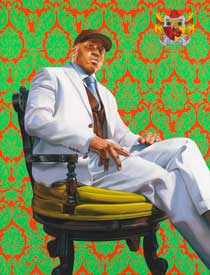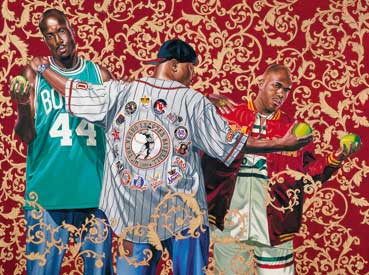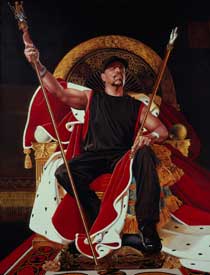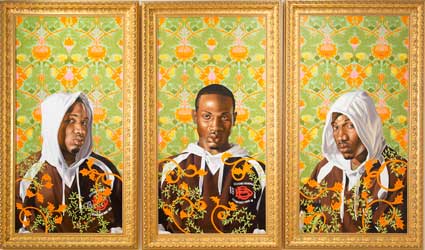Painting: Kehinde Wiley
For most of Kehinde Wiley’s very successful career, he has created large, vibrant, highly patterned paintings of young African American men wearing the latest in hip hop street fashion. The theatrical poses and objects in the portraits are based on well-known images of powerful figures drawn from seventeenth- through nineteenth-century Western art. Pictorially, Wiley gives the authority of those historical sitters to his twenty-first-century subjects. In 2005, VH1 commissioned Wiley to paint portraits of the honorees for that year’s Hip Hop Honors program. Turning his aesthetic on end, he used his trademark references to older portraits to add legitimacy to paintings of this generation’s already powerful musical talents. In Wiley’s hands, Ice T channels Napoleon, and Grandmaster Flash and the Furious Five take on a seventeenth-century Dutch civic guard company.
Arist's Statement: Kehinde Wiley
Kehinde Wiley’s portraits of African American men collate modern culture with the influence of Old Masters. Incorporating a range of vernaculars culled from art historical references, Wiley’s work melds a fluid concept of modern culture, ranging from French Rococo to today’s urban landscape. By collapsing history and style into a unique contemporary vision, Wiley interrogates the notion of master painter, “making it at once critical and complicit.” Vividly colorful and often adorned with ornate gilded frames, Wiley’s large-scale figurative paintings, which are illuminated with a barrage of baroque or rococo decorative patterns, posit young black men, fashioned in urban attire, within the field of power reminiscent of Renaissance artists such as Tiepolo and Titian.
For “RECOGNIZE!” Wiley has included paintings from his body of work, Hip Hop Honors, depicting some of the foot soldiers of the hip hop movement. The artists chose poses—taken from Wiley’s personal art book collection—that best suited the performative and personal aspects of their character. The coalition of the anonymous subject with the allure of personality allows this body of work to engage celebrity and status directly.
Value, in all its meanings, has always played a role in culture. Unlike its precursors—classical, jazz, rock—which have since been canonized and given an art-historical time frame and construct, hip hop continues to be seen merely as entertainment; a cultural hindrance. This series of Wiley’s portraits speaks specifically to that juxtaposition and the retooling of importance and to whom and when it is deemed.








